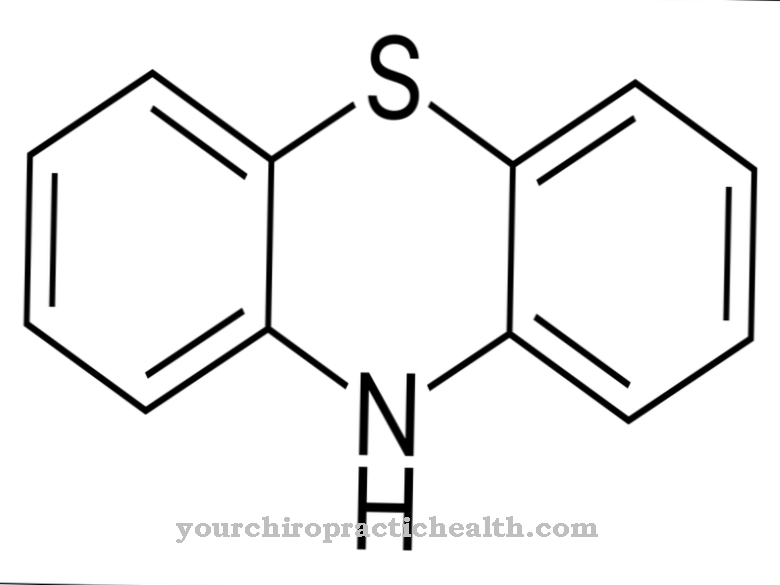Bromperidol is one of the active ingredients that are contained in the classic neuroleptics. The highly potent substance has a strong antipsychotic effect. It is one of the successor substances to haloperidol, which was widely used in psychiatric clinics under the Haldol® label from the mid-1960s.
What is bromperidol?

Bromperidol has the molecular formula C21H23BrFNO2 and is an active ingredient that particularly effectively combats the positive symptoms of schizophrenia (hallucinations, delusional thoughts, etc.).
It was marketed under the brand names Bromidol® and Bromodol® after its development by Janssen Pharmaceutica in 1966. Today it is also contained in the drugs Impromen® and Tesoprel®, for example.
Bromperidol belongs to the class of butyrophenones, which are used exclusively to treat schizophrenia. The members of this group of active ingredients all have a 1-phenyl-1-butenone building block. Since bromperidol was one of the first anti-psychotics to be synthesized at the time, it is considered a classic or typical neuroleptic. Because of its strong anti-psychotic properties, it is a highly potent active ingredient, because even a low dose of bromperidol has a high effect.
However, as a powerful antipsychotic, it is only mildly sedating. It cannot regulate restlessness, sleep disorders, anxiety and states of excitement such as those that occur during a psychotic episode. Therefore, bromperidol is usually administered together with a low-potency neuroleptic in acute psychoses.
Pharmacological effect
The positive symptoms of schizophrenic psychoses are generally believed to be caused by an excessive concentration of the neurotransmitter dopamine in the meso-limbic part of the brain. Bromperidol, like the other representatives of its group of active ingredients, is able to block the release of the messenger substance by acting as a D2 receptor antagonist. The misunderstandings of reality, misperceptions and the psychomotor agitation subside.
However, if a neuroleptic with a strong sedative effect is not administered at the same time, the negative symptoms may intensify.
Schizophrenia can only be treated symptomatically with bromperidol. However, the patient comes to rest and is able to perceive his condition as pathological.
Medical application & use
Before treatment with bromperidol, a blood count will be performed, which will be supplemented by a differential blood count. The dosage of the drug is carried out individually. The average dose is 5 to 20 mg bromperidol daily. The maximum dose is set at 50 mg. In acute therapy, as with other neuroleptics, a higher dose is administered than in long-term and relapse prophylaxis.
In long-term therapy, the patient receives the drug together with their meal. The effect occurs quickly after an initial administration: symptoms such as acoustic and visual hallucinations as well as paranoid ideas usually subside soon.
Bromperidol has an anti-psychotic effect 50 times stronger than chlorpromazine. Chlorpromazine was the first neuroleptic active ingredient at the time and is used as a reference value when comparing the effectiveness of classic neuroleptics. In contrast to low-potency drugs for schizophrenia, bromperidol does not make you tired and also does not cause blood pressure to drop, which reduces the risk of circulatory collapse.
You can find your medication here
➔ Medicines to calm down and strengthen nervesRisks & side effects
As a highly potent anti-psychotic agent, bromperidol also has many side effects, the worst of which is extrapyramidal syndrome (EPS). The patients then develop symptoms similar to Parkinson's disease with muscle stiffness (rigidity), sitting restlessness, tremors (tremor) etc. Therefore, people with schizophrenia with this secondary disease are also given anticholinergics.
Treatment with bromperidol causes a structural change in the brain substance, depending on the dose level and duration of therapy. In animal experiments, brain volume and weight (neuro-degeneration) decreased by about 10%.
The most common side effects that can occur when taking bromperidol are a lack of white blood cells (leukopenia), reduction in the number of blood cells (anemia), hair loss, early and late dyskinesia, extrapyramidal syndrome, dyspnoea, pneumonia, thromboembolism, and Parkinson's symptoms involuntary movements such as looking, swallowing and tongue spasms and extreme restlessness. Occasionally, hypotension, accelerated heart rate and peripheral edema can occur. In rare cases, diarrhea, nausea, vomiting, loss of appetite, vegetative symptoms, allergic reactions, drowsiness, cerebral seizures, speech and memory disorders, sleep problems, neuroleptic malignant syndrome and depressive moods have been observed.
Bromperidol should not be used in patients with comatose states, para group allergy, children under 12 years of age and people with cardiac, renal, or hepatic insufficiency, enlarged prostate with residual urine formation, acute urinary retention, severe hypotension, Parkinson's disease, endogenous depression, Have organic brain diseases, severe epilepsy, hyperthyroidism, a known allergy to the active ingredient, glaucoma, heart attack and an acute drug or alcohol dependence.
Damage to fertility has been demonstrated in animal experiments. Although there is not yet any evidence of similar effects in humans, the active ingredient should only be used with extreme caution in pregnant women. Infants born to mothers who received bromperidol while breastfeeding later showed extrapyramidal symptoms. In patients with heart damage and the elderly, it could lead to a disturbance in the conduction of the heart.
Since bromperidol, like other neuroleptics, favors the release of prolactin, which is regarded as the triggering substance in some types of cancer, such as breast cancer, it should also only be used in patients with breast cancer if there is an urgent need. The same goes for people with abnormal blood values.
In all of these cases, regular medical monitoring of the patient must be ensured. Since the active ingredient lowers the seizure threshold in epileptics, for example, it may only be administered to them if they are also receiving anticonvulsants. Alcoholic beverages and sedatives increase the effects of bromperidol, but tea, coffee and other beverages containing caffeine weaken its effects.



























